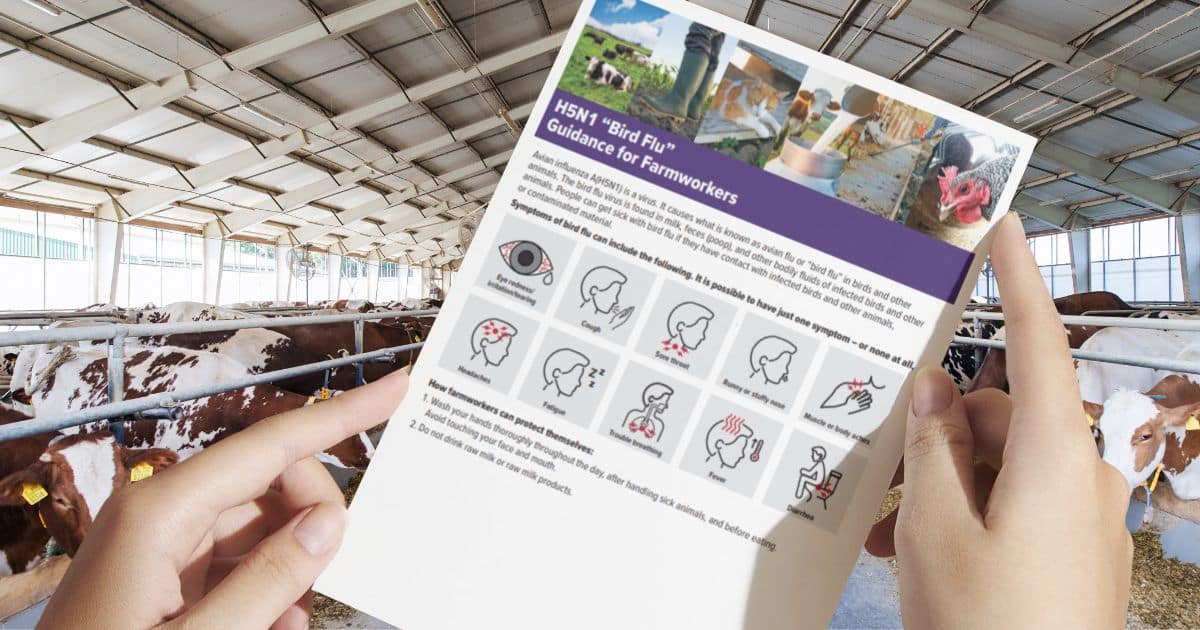News
RFK’s New Dietary Guidelines Delayed Again, Amid Concerns
Diet•6 min read
Solutions
Amid heightened fears of immigration raids, Alianza Agricola has spent months educating hundreds of their coworkers on how to prepare for an avian flu outbreak.


Words by Grey Moran
Every month, around 50 dairy farmworkers filter into a church basement in western New York after a grueling day of work. They order dinner from a local Mexican or Puerto Rican restaurant, and settle in to discuss how to organize for their rights to a dignified life and workplace under increasingly strained conditions. Under the Trump Administration, the largely immigrant workforce is facing an uptick of attacks on their rights. At the same time, the group is bracing for outbreaks of avian flu on New York dairy farms, and working to educate their coworkers on how to stay as safe as possible from the virus.
The rapidly circulating avian flu has yet to be detected in New York’s dairy herds, but these farmworkers — members of Alianza Agricola, a group dedicated to fighting for the rights of dairy workers and their communities — don’t want to take any chances.
Already detected in New York’s wild birds, a range of wild mammals and multiple poultry farms, the virus could soon hit the state’s dairy industry — New York’s largest agricultural sector, spanning almost 2,800 dairy farms and employing thousands of farmworkers. While the virus is still considered low-risk to the general public, it poses a greater risk to dairy workers who directly feed, medicate and milk the cows from dawn to dusk.
So far, nearly all of the 68 human cases of the U.S. outbreak of the virus have been in poultry or dairy farmworkers, according to the Centers for Disease Control (CDC).
Yet members of Alianza Agricola say that farmworkers in their group have not received education or training in their workplaces about how to protect themselves from the virus. This has prompted them to take matters into their own hands. Over the past few months, the group has educated hundreds of other farmworkers on how to prepare for avian flu, including by traveling directly to dairy farms and providing education at their meetings.
“None of the employers have given us any information about this,” Luis Jiménez, a dairy farmworker and the president Alianza Agricola, tells Sentient. “All of the information I have — and that we’ve been able to share with other workers — is because we’ve been able to inform ourselves from other institutions.”
The CDC has issued interim guidance for employers to protect farmworkers and other people working with animals from avian flu, recommending that employers train workers on how to identify the virus and other infection control practices. Yet this guidance is voluntary, without any means of enforcing or even widely distributing it — creating a significant gap in worker protections, in New York and across the country.
Even in states where H5N1 virus is already circulating in dairy herds, advocates have observed that dairy farmworkers lack basic training and information on the virus.
“A lot of workers have told us that they weren’t told anything, which actually really stresses people out. When cows were getting sick, they weren’t told why,” said Bethany Alcauter, who directs research and public health programs for the National Center for Farmworker Health. “Many workers were really concerned that they were doing something to make the cow sick, and it caused a fair amount of distress,” she added.
If the virus were to strike New York’s dairy farms, these farmworkers — low-wage, largely unauthorized workers without health insurance — would be on the frontlines. Beyond protecting other farmworkers from H5N1, Alianza Agricola’s outreach helps prevent the spread of the virus to more farm and wild animals, and the rising risk of its spread into the general public if it were to mutate to become transmissible between humans.
“Farmworkers, of course, are the most vulnerable to the disease because they’re the ones working with the animals,” said Delcianna Winders, the director of Animal and Law Policy Institute at Vermont Law School. “But then, of course, they don’t live in isolated bubbles. They live in larger communities, and so when they go out into those communities, they’re at the highest risk of spreading the virus to other members of the community.”
Jiménez says that they’ve worked with the New York Department of Health, the Cornell Farmworker Program and other institutions outside of the state to ensure that their educational materials on the quickly evolving virus are accurate and up-to-date. This has involved printing and distributing a brochure (in Spanish and English) on “H5n1 Guidance for Farmworkers” to about 500 dairy workers so far, according to Jiménez.
The brochure explains how the virus can spread through milk, feces and other body fluids of the infected animals and provides guidance on how farmworkers can reduce exposure to the virus.
While Jiménez has encountered some farmworkers who have never heard of avian flu, the majority of workers are familiar with it. More frequently, he encounters farmworkers who are confused about the public health risks of the virus, while not realizing that they are the human population at the highest risk of contracting the virus.
Other farmworkers always tell us that they believe you can’t get infected so easily, says Jiménez, “or that it’s like any normal flu. So we tell them that, ‘no, it’s different symptoms, and it’s very easy to get infected if you work with infected animals.”’

The brochure also includes information on how to identify symptoms of the virus in humans with clear visual graphics, though it also notes that some humans may be infected but asymptomatic. Finally, the brochure provides farmworkers with QR codes and links on how they can get tested for the virus through a local health department and receive health services through New York’s statewide occupational health clinics.
At every meeting, Jiménez says they pass out the brochures. “We tell them, ‘Don’t forget, we have brochures to be informed about what is happening and what avian flu is,’” he says. They also host meetings dedicated to discussing the virus, sometimes with speakers like Mary Jo Dudley, the Director of the Cornell Farmworker Program, who spoke with the group about how to prepare. They’re currently working with Dudley and the New York Department of Health to put out a graphic video with further guidance for farmworkers on the virus.
Dudley says she fielded questions from farmworkers about how they would be able to know if the virus is spreading through cattle — questions that are critical not only to the safety of farmworkers but also to the broader prevention of the virus.
“There’s a lot of questions about how would we detect it if the cows have it? How is it spread?” Dudley tells Sentient. “So it’s spread through milk. So milk includes splatter. Splatter gets into manure. So there’s all these different levels. How do you protect people at each level?” As H5N1 continues to spread, the answers to these questions are also evolving — particularly as some scientists are concerned the virus may be gaining mutations to become airborne.
In addition to the looming threat of avian flu, the recent uptick in raids led by ICE or Immigration and Customs Enforcement officials since Trump returned to the White House has heightened fears and anxieties among farmworkers.
In recent weeks, Dudley says that she has observed both ICE and local enforcement parked directly outside health clinics where New York farmworkers would seek care if exhibiting symptoms of the virus. “That creates pause,” says Dudley, “Are you going to try to go into that health center, you know?”
Dudley has also heard concerns from farmworkers about the prospect of government personnel entering farms should there be an outbreak. “If there is an event with avian flu, then the first step is that inspectors will come to inspect the herd,” she says. Yet in this environment of heightened immigration enforcement, Dudley says, farmworkers are more suspicious of strangers and government officials who come to their workplaces.
“There’s a lot of government vigilance,” says Dudley. “When you see somebody who you interpret to be a representative of the government, you can’t differentiate between what they’re there for,” which can create fear and confusion.
Dudley recommends that dairy operators put a sign in front of the farm entrance that reads, “No Visitors Allowed for Biosecurity Reasons,” along with a number that any invited visitors can call if they need to inspect or conduct business on the farm. (The biosecurity issue isn’t a cover; visitors on farms can increase the risk of tracking in avian flu.)
Jiménez says they’ve provided virtual and in-person trainings to the local community in western New York on how to respond to ICE raids. “Right now, we’re in this difficult situation with the new administration, so we’re asking allies to be alert,” he says. “If the police call ICE, I think that the allies can help by looking for people in detention centers, supporting the families or writing letters saying that the workers are part of the community and they are just working and being good neighbors.”
In the meantime, Jiménez plans to keep working hard at his job at an large-scale dairy farm where his role is tending to the calves. “The weapon that we use as workers is doing good and responsible work,” he says. “We are always going to have that as a tool for organizing.” Alianza Agricola has won what seemed like an impossible fight before, successfully pushing New York to allow undocumented immigrants to obtain drivers’ licenses.
While the fights ahead may be even larger, Jiménez has never been one to give into fear: he plans to keep organizing with other farmworkers to prepare for both the risks of immigration enforcement and the avian flu hitting New York dairy farms. The future may be deeply uncertain, but Alianza Agricola is informed and ready.